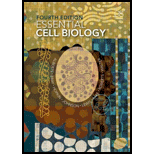
To explain: How water molecules reorganize into a cage-like structure around the hydrophobic compounds.
Introduction: Water molecules in the ice are arranged in such a way that forms a cage-like structure due to the formation of intermolecular hydrogen bond in between the oxygen and hydrogen atom of two different water molecules.
Explanation of Solution
Refer to the Fig 11-9, “A hydrophobic molecules tend to avoid water”, in the text book. It shows the reorganization of water molecules into a cage-like structure around the hydrophobic compound. Hydrophobic molecules are water insoluble molecules that cannot form favorable interaction with the water molecules.
The hydrogen bonds between the water molecules are continuously broken and formed by the action of thermal motion. When a water molecule comes near to the hydrophobic molecules, its motion is restricted because hydrogen bonds cannot be formed in the direction of hydrophobic molecules. As a result, they force adjacent water molecules to reorganize into a cage-like structure around them.
To compare: The cage-like structure of water with ice.
Introduction: Water molecules in the ice are arranged in such a way that forms a cage-like structure due to the formation of intermolecular hydrogen bond in between the oxygen and hydrogen atom of two different water molecules.
Explanation of Solution
The hexagonal ice gives an open cage-like structure because each oxygen atom in the ice is surrounded by four hydrogen atoms by covalent bond and hydrogen bond. The cage-like structure is less organized, more transient, and considerably less network than a small crystal of ice.
To explain: Why the cage-like structure would be energetically unfavorable.
Introduction: Water molecules in the ice are arranged in such a way that forms a cage-like structure due to the formation of intermolecular hydrogen bond in between the oxygen and hydrogen atom of two different water molecules.
Explanation of Solution
The cage-like structure is a highly ordered structure. During its formation, free energy is required and the cost of the free energy is decreased when the hydrophobic molecules are aggregated to form a cluster. The entropy of the system decreases; hence, the “cage-like” structure would be energetically unfavorable.
Want to see more full solutions like this?
- 22. Which of the following mutant proteins is expected to have a dominant negative effect when over- expressed in normal cells? a. mutant PI3-kinase that lacks the SH2 domain but retains the kinase function b. mutant Grb2 protein that cannot bind to RTK c. mutant RTK that lacks the extracellular domain d. mutant PDK that has the PH domain but lost the kinase function e. all of the abovearrow_forwardWhat is the label ?arrow_forwardCan you described the image? Can you explain the question as well their answer and how to get to an answer to an problem like this?arrow_forward
- Describe the principle of homeostasis.arrow_forwardExplain how the hormones of the glands listed below travel around the body to target organs and tissues : Pituitary gland Hypothalamus Thyroid Parathyroid Adrenal Pineal Pancreas(islets of langerhans) Gonads (testes and ovaries) Placentaarrow_forwardWhat are the functions of the hormones produced in the glands listed below: Pituitary gland Hypothalamus Thyroid Parathyroid Adrenal Pineal Pancreas(islets of langerhans) Gonads (testes and ovaries) Placentaarrow_forward
 Human Anatomy & Physiology (11th Edition)BiologyISBN:9780134580999Author:Elaine N. Marieb, Katja N. HoehnPublisher:PEARSON
Human Anatomy & Physiology (11th Edition)BiologyISBN:9780134580999Author:Elaine N. Marieb, Katja N. HoehnPublisher:PEARSON Biology 2eBiologyISBN:9781947172517Author:Matthew Douglas, Jung Choi, Mary Ann ClarkPublisher:OpenStax
Biology 2eBiologyISBN:9781947172517Author:Matthew Douglas, Jung Choi, Mary Ann ClarkPublisher:OpenStax Anatomy & PhysiologyBiologyISBN:9781259398629Author:McKinley, Michael P., O'loughlin, Valerie Dean, Bidle, Theresa StouterPublisher:Mcgraw Hill Education,
Anatomy & PhysiologyBiologyISBN:9781259398629Author:McKinley, Michael P., O'loughlin, Valerie Dean, Bidle, Theresa StouterPublisher:Mcgraw Hill Education, Molecular Biology of the Cell (Sixth Edition)BiologyISBN:9780815344322Author:Bruce Alberts, Alexander D. Johnson, Julian Lewis, David Morgan, Martin Raff, Keith Roberts, Peter WalterPublisher:W. W. Norton & Company
Molecular Biology of the Cell (Sixth Edition)BiologyISBN:9780815344322Author:Bruce Alberts, Alexander D. Johnson, Julian Lewis, David Morgan, Martin Raff, Keith Roberts, Peter WalterPublisher:W. W. Norton & Company Laboratory Manual For Human Anatomy & PhysiologyBiologyISBN:9781260159363Author:Martin, Terry R., Prentice-craver, CynthiaPublisher:McGraw-Hill Publishing Co.
Laboratory Manual For Human Anatomy & PhysiologyBiologyISBN:9781260159363Author:Martin, Terry R., Prentice-craver, CynthiaPublisher:McGraw-Hill Publishing Co. Inquiry Into Life (16th Edition)BiologyISBN:9781260231700Author:Sylvia S. Mader, Michael WindelspechtPublisher:McGraw Hill Education
Inquiry Into Life (16th Edition)BiologyISBN:9781260231700Author:Sylvia S. Mader, Michael WindelspechtPublisher:McGraw Hill Education





